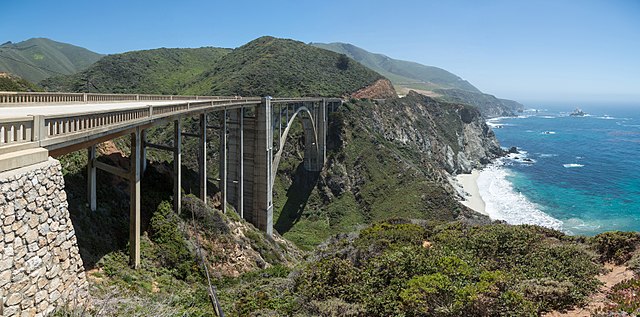The Old Coast Road is a dirt road that still exists in part and preceded the current Big Sur Coast Highway along the northern coast of Big Sur, California. It was initially a trail created by Rumsen and Esselen Native Americans to travel along the coast in present-day Monterey County, California. Soon after the Spanish arrived, Governor Teodoro Gonzalez granted land that included portions of the trail as Rancho San Jose y Sur Chiquito to Marcelino Escobar in 1835. Governor Juan Alvarado re-granted the land to Escobar the same year. The Rancho included land from Carmel to near Palo Colorado Canyon. José Castro gained possession of the land in about 1848. He improved the trail from Monterey to Palo Colorado Canyon as early as 1853. A hand-drawn map created c. 1853 accompanying the grant indicated a road or trail was already present along the coast.
Old Coast Road at Bixby Creek Bridge
Big Sur Coast Highway is a section of California State Route 1 through the Big Sur region of California that is widely considered to be one of the most scenic driving routes in the United States, if not the world. It is both a National Scenic Highway and a California Scenic Highway, and was described by Australian painter Francis McComas as the "greatest meeting of land and water in the world". Condé Nast Traveler named State Route 1 through Big Sur one of the top ten world-famous streets, comparable to Broadway in New York City and the Champs-Élysées in Paris. The road itself is a destination for visitors.
Highway 1 near Ragged Point at the southern end of the Big Sur region
Convict labor from Folsom Prison was paid 35 cents per day to help build the roadway.
Bixby Canyon Bridge under construction in 1932
Bixby Creek Bridge, May 2013





